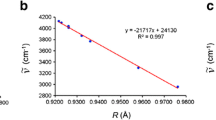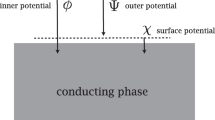Conclusions
-
1.
A model potential of the hydrogen bond in water dimer can be represented in the form of a sum of long-range charge-dipole attraction, short-range attraction, and exponential repulsion. Here, by a proper selection of parameters, a good description can be given for the dependence of the bond energy on the interatomic distance R.
-
2.
The presence of a finite zero energy of the proton and the coupled character of the atomic vibrations in the H2O molecule lead to a certain redetermination of the parameters of the model potential V(r, R). In particular, the depth of the potential well for the O−H bond increases, as does the parmeter C of Coulomb attraction.
-
3.
The relatively low-lying excited quantum levels of the proton and its analytical wave function can be obtained with an adequate degree of accuracy by means of a simplified potential V(r, R) that has the from of a Morse potential with parameters depending on the interatomic distance R. This simplified potential gives a correct reproduction of the form of V(r, R) close to the equilibrium position of the protonr≈r 0.
-
4.
The dependence of the bond energy E(R) has the required form, with the radius of action of the forces of the hydrogen bond and their magnitude becoming slightly greater with increasing sequence number of excitation. In particular, the work of shortening the distance R from ∞ to Ro for the first excited state amounts to about 45% of the excitation energy.
Similar content being viewed by others
Literature Cited
R. Rein and F. E. Harris, J. Chem. Phys.,43, No. 12, 4415 (1965).
S. Zunell and G. Sperber, J. Chem. Phys.,46, No. 6, 2119 (1967).
E. Clementi, J. Meil, and W. Van Niessen, J. Chem. Phys.,54, No. 2, 508 (1971).
G. H. Dierksen, Theor. Chim. Acta,21, 335 (1971).
O. Matsuoca, E. Clementi, and M. Yoshimine, J. Chem. Phys.,64, No. 4, 1351 (1976).
R. Schröder and E. R. Lippincott, J. Phys. Chem.,61, No. 7, 921 (1957).
C. Reid, J. Chem. Phys.,10, No. 1, 182 (1959).
Collection: The Hydrogen Bond [in Russian], Nauka, Moscow (1981), p. 1.
P. Shuster, From Diatomic to Biological Molecules, A. Pullman, ed., Wiley, New York (1977), p. 123.
Author information
Authors and Affiliations
Additional information
Translated from Zhurnal Strukturnoi Khimii, Vol. 26, No. 4, pp. 65–71, July–August, 1985.
Rights and permissions
About this article
Cite this article
Grebneva, E.A., Tolpygo, K.B. Proton potential and properties of hydrogen bond. J Struct Chem 26, 546–552 (1985). https://doi.org/10.1007/BF00754127
Received:
Issue Date:
DOI: https://doi.org/10.1007/BF00754127




